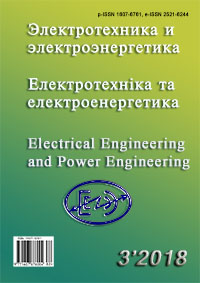SYSTEM REQUIREMENTS TO THE EFFICIENCY OF HYDRO ELECTRIC POWER STATIONS
DOI:
https://doi.org/10.15588/1607-6761-2018-3-3Keywords:
hydro energy, reserve of powers, dynamics of hydro aggregate, hydro generator, efficiencyAbstract
Purpose. Determination of the reserves of the main equipment in terms of the systemic role of hydroelectric power stations.
Methodology. Complex poliobjecting approach to the analysis and determination of operating constituents of generation and basic energy equipment.
Findings. The urgency and the basis of the system requirements for the efficiency of the power equipment of hydroelectric power stations, which allows ensuring the formation of the necessary functional level of the generation process is proposed. The features of the main components of the transformation technology and their interaction are considered. Reflects the influence of the components of the end-to-end path of the generation process. Characteristics of the conversion efficiency in the mobility conditions are obtained. The main possibilities and ways of organizing an effective energy exchange of a hydro generator are shown. The ways of increasing the operating efficiency of the existing equipment of hydroelectric power stations are proposed.
Originality. The multi-subject requirements of the system approach is proposed for determining equipment reserves and increasing generation efficiency, which makes it possible to determine the dynamic generation components and performance criteria.
Practical value. The system requirements for studying the end-to-end path of energy transformations and increasing the efficiency of generating of basic equipment of the hydroelectric power stations and its systemic role are determined.
References
[1] Chestnat, G. (1969). Tehnyka bol'shyh system. Moscow: Energyja, 656.
[2] Klishevich, G. V. (1969). Energoprotsess gidroenergeticheskih ustanovok. Leningrad: Energiya, 164.
[3] Кitayev, A., Agbomassou, V., & Glukhova, V. (2013). Schemes of electric machines replacement. Electrical Engineering And Power Engineering, 2, 14-25. doi:http://dx.doi.org/10.15588/1607-6761-2013-2-2
[4] Osin, I. L., Shakaryan, Yu. G. (1990). Elektricheskie mashi-nyi. Sinhronnyie mashinyi. Moscow: Vyisshaya shkola, 304.
[5] Emtsev, B. T. (1987). Tehnicheskaya gidromehanika. Moscow: Mashinostroenie, 460
[6] Barlit, V. V. (1977). Gidravlicheskie turbinyi. Kyiv: Vischa shkola, 360.
[7] Beus, Н. L. (1970). The use of information in sorting. JACM, 17, 3.
[8] Hellerman, L. (1972). A measure of computational work. IEEE Trans, 21, 5, 439-446.
[9] Pojuev, V., Radchenko, V., Skrabets, F., Kucher, V., & Kobets, V. (2013). Definition of efficiency of existing hydropower systems. Electrical Engineering And Power Engineering, 2, 71-76. doi:http://dx.doi.org/10.15588/1607-6761-2013-2-10
[10] Drammond, M. (1977). Metodyi otsenki i izmereniy dis-kretnyih vyichislitelnyih system. Moscow: Mir, 381.
[11] Mironov, V. G. (2001). Osnovyi tehnologiy tsifrovoy obrabotki signalov. Ch. 1. Svoystva signalov i sovremennyie tehnicheskie sredstva ih obrabotki. Elektrichestvo, 3, 55-65.
[12] Mironov, V. G. (2001). Osnovyi tehnologiy tsifrovoy obrabotki signalov. Ch. 2. Matematicheskoe opisa-nie tsifrovyih signalov. Elektrichestvo, 8, 60-69.
[13] Palyu de La Barer, R. (1973). Kurs teorii avtomatiche-skogo upravleniya. Moscow: Mashinostroenie, 396.
[14] Shannon, Robert E. (1975). Systems Simulation: The An and Science. Englewood Cliffs, N. J.: Prentice-Hall, 4.
[15] Dandeno, P.L., Hauth, R.L., Schulz, R. (1973). Effects Synchronous machine modelling in large scale system stability. Trans. IEEE, 92, 2, 574-582.
[16] Radchenko, V. V. (2015). Pidvyshhennja dynamichnoi' efektyvnosti systemy zbudzhennja gidrogeneratora. Visnyk NUVGP, 2 (62), 262-275.
[17] Radchenko, V. V. (2012). Semantika informatsiynih skladovih energetichnih protsesiv. Girnycha elektromehanIka ta avtomatika, 89, 87-91.
[18] Radchenko, V. V. (2016). Polipredmetnyj analiz efektyvnosti gidroagregata GES. Girnycha elektromehanIka ta avtomatika, 97, 112-116.
Downloads
Published
How to Cite
Issue
Section
License
Copyright (c) 2018 V. V. Radchenko

This work is licensed under a Creative Commons Attribution 4.0 International License.
Creative Commons Licensing Notifications in the Copyright Notices
Authors who publish with this journal agree to the following terms:
Authors retain copyright and grant the journal right of first publication with the work simultaneously licensed under aCreative Commons Attribution License that allows others to share the work with an acknowledgement of the work's authorship and initial publication in this journal.
Authors are able to enter into separate, additional contractual arrangements for the non-exclusive distribution of the journal's published version of the work (e.g., post it to an institutional repository or publish it in a book), with an acknowledgement of its initial publication in this journal.
Authors are permitted and encouraged to post their work online (e.g., in institutional repositories or on their website) prior to and during the submission process, as it can lead to productive exchanges, as well as earlier and greater citation of published work.

